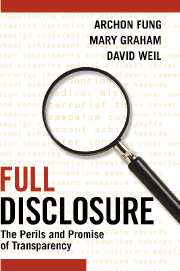Book contents
- Frontmatter
- Dediaction
- Contents
- List of Figures and Tables
- Preface
- 1 Governance by Transparency
- 2 An Unlikely Policy Innovation
- 3 Designing Transparency Policies
- 4 What Makes Transparency Work?
- 5 What Makes Transparency Sustainable?
- 6 International Transparency
- 7 Toward Collaborative Transparency
- 8 Targeted Transparency in the Information Age
- Appendix: EighteenMajor Cases
- Notes
- Bibliography
- Index
6 - International Transparency
Published online by Cambridge University Press: 27 July 2009
- Frontmatter
- Dediaction
- Contents
- List of Figures and Tables
- Preface
- 1 Governance by Transparency
- 2 An Unlikely Policy Innovation
- 3 Designing Transparency Policies
- 4 What Makes Transparency Work?
- 5 What Makes Transparency Sustainable?
- 6 International Transparency
- 7 Toward Collaborative Transparency
- 8 Targeted Transparency in the Information Age
- Appendix: EighteenMajor Cases
- Notes
- Bibliography
- Index
Summary
Transparency policies have the potential to reduce risks and improve public services in the United States, although they must overcome many obstacles to do so, as we have seen. But can targeted transparency reduce risks and improve services that cross national boundaries? That is a more difficult question.
Assessing three important cross-border transparency policies, we find preliminary evidence that such policies can help further nations’ shared agendas, even when no overarching treaty guides international action. At best, targeted transparency provides a form of governance without government.
In some ways, international transparency policies work like domestic policies. The analytical framework we have developed to assess the effectiveness of domestic policies can also assess the effectiveness of international policies. The effectiveness of international policies, like that of domestic policies, depends heavily on whether policies are user-centered and improve over time. But international policies also confront two unique challenges. First, they must earn legitimacy. Second, theymust become embedded not only in the decision routines of information users and disclosers but also in national laws, regulations, and enforcement practices of participating nations.
Whether targeted transparency can become a useful tool of international governance is a question with new urgency. Markets are integrating rapidly, while governance remains fragmented, defined by traditional national geographical boundaries. National governments have increasing difficulty framing rules for markets and for collective action unilaterally.
At the same time, the failure of national transparency systems can have dire international consequences, as two recent examples illustrate.
In 2001–2002, the sudden collapse of Enron, WorldCom, and other respected U.S. companies destroyed the savings of investors not only in the United States but around the world. The failure of U.S. financial accounting rules to keep up with market changes increased risks to investors – without regard to national boundaries. Reforms became an international effort.
In 2003, the outbreak of a virulent infectious disease known as Severe Acute Respiratory Syndrome (SARS) spread from a few villages in China to thirty countries in six months. National transparency failed as Chinese officials delayed reporting of provincial outbreaks. Late and incomplete information created international panic. In the end, SARS killed more than 700 people and caused an estimated $40 billion in economic losses.
Of course, the growing interdependence of nations has increased calls for strengthened international institutions.
- Type
- Chapter
- Information
- Full DisclosureThe Perils and Promise of Transparency, pp. 107 - 150Publisher: Cambridge University PressPrint publication year: 2007
- Creative Commons
- This content is Open Access and distributed under the terms of the Creative Commons Attribution licence CC-BY-NC 4.0 https://creativecommons.org/cclicenses/



